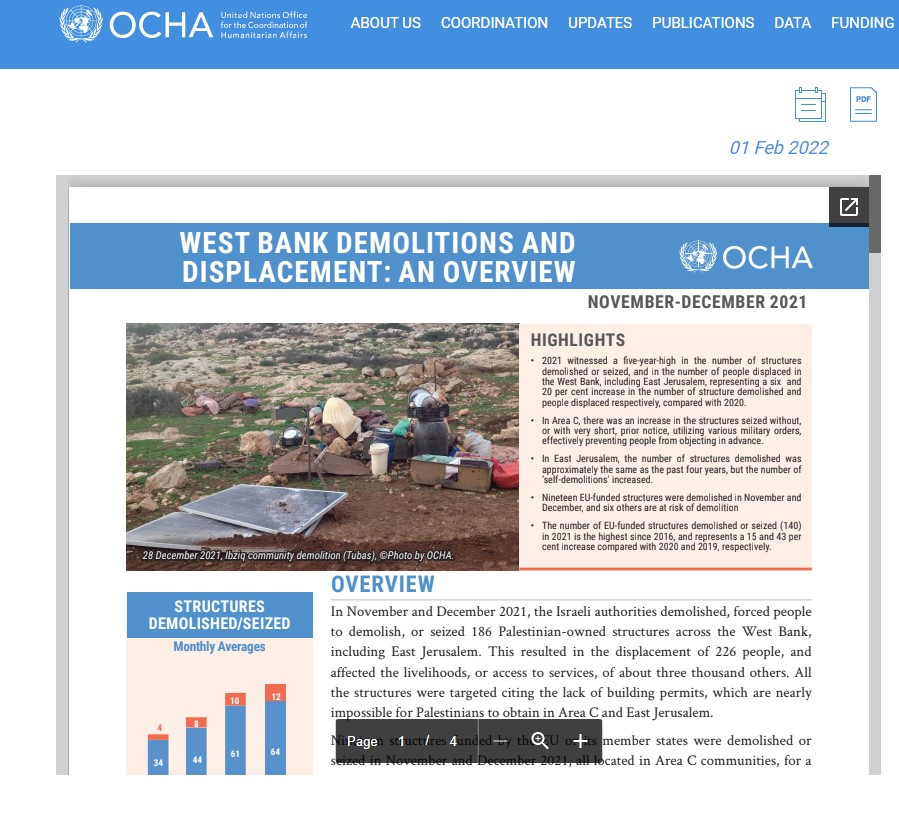The United Nations Office for the Coordination of Humanitarian Affairs (OCHA): West Bank Demolition and Displacement Report
Highlights
• 2021 witnessed a five-year-high in the number of structures demolished or seized, and in the number of people displaced in the West Bank, including East Jerusalem, representing a six and
20 % increase in the number of structures demolished and people displaced respectively, compared with 2020.
• In Area C, there was an increase in the structures seized without, or with very short, prior notice, utilizing various military orders, effectively preventing people from objecting in advance.
• In East Jerusalem, the number of structures demolished was approximately the same as the past four years, but the number of ‘self-demolitions’ increased.
• Nineteen EU-funded structures were demolished in November and December, and six others are at risk of demolition.
• The number of EU-funded structures demolished or seized (140) in 2021 is the highest since 2016, and represents a 15 and 43 % increase compared with 2020 and 2019, respectively.
Overview
In November and December 2021, the Israeli authorities demolished, forced people to demolish, or seized 186 Palestinian-owned structures across the West Bank, including East Jerusalem. This resulted in the displacement of 226 people, and affected the livelihoods, or access to services, of about three thousand others. All the structures were targeted citing the lack of building permits, which are nearly impossible for Palestinians to obtain in Area C and East Jerusalem.
Nineteen structures funded by the EU or its member states were demolished or seized in November and December 2021, all located in Area C communities, for a total value of more than 71,000 euros. Another six structures funded by the EU or its member states, at a value of about 6,500 euros, received warning or stop-work orders in Al Hadidiya herding community in the northern Jordan Valley and Khirbet Jamrura in Hebron. Additionally, four water tanks and over 270 saplings provided by the EU were reportedly vandalized by Israeli settlers.
On 1 November, the Israeli authorities demolished two residential tents, one livelihood tent and a solar panel system in Hammamat al Maleh-Al Meiteh in Tubas. As a result, one Palestinian family comprising nine people, including seven children, was displaced. In the same incident, another residential and an animal structure were also demolished.
In two separate incidents, on 23 and 28 November, an oPt Humanitarian Fund funded agricultural road in Asira ash Shamaliya, Nablus, was demolished, affecting access to livelihoods for about 200 families, and a water transmission network funded by the EU in Khirbet ‘Atuf, Tubas, was demolished, which would have benefited around 80 local Palestinian families.
In another three separate incidents in December, an additional ten structures funded by the EU or its member states were demolished or seized in three different communities located in areas designated by the Israeli authorities as firing zones for military training. In one of these incidents in the herding community of Mirkez in the Massafer Yatta area of Hebron, the Israeli authorities demolished four residential tents. As a result, four Palestinian families comprising 18 people, including five children, were displaced. Massafer Yatta is in a firing zone designated for military training and the 1,300 people in 14 communities living there are at heightened risk of forcible transfer.
Forty-seven structures were demolished in East Jerusalem, displacing 118 people, of which 18 were demolished by their owners. On 14 December, three Palestinian households ‘self demolished’ their two residential structures in Silwan in East Jerusalem, displacing 29 people, including 12 children.
In total in 2021, 902 structures were demolished or seized, the vast majority, 898, for lack of building permits. This is the highest number of demolitions recorded in the West Bank, including East Jerusalem, since 2016. The number of people displaced, 1,203, also represents a five-year-high.
In Area C, of the 718 structures targeted in 2021, 381 (53 %) were seized without, or with very short, prior notice, utilizing various military orders, effectively preventing people from objecting in advance. This compares with about 31 % in the previous three years, and around 10 % in 2016-17.
The number of structures demolished in East Jerusalem in 2021 for lack of building permits, 177, is approximately the same as the past four years (2017-2019). However, the proportion of buildings demolished by their owners in 2021 reached 55 %, up from 50 p% in 2020, and an average of 23 % in the previous three years (2017-2019). Anecdotal evidence suggests that this increase in ‘self-demolitions’ is related to new Israeli legislation passed in recent years. This legislation has made it more difficult for Palestinian residents to protect their properties and avoid displacement via legal proceedings, increased fines and other penalties, while making it easier for the Jerusalem Municipality to pressure them to demolish their properties by themselves. In 2021, the number of EU-funded structures that were demolished or seized (140) is the highest since 2016, and represents a 15 and 43 % increase compared with 2020 and 2019, respectively.

